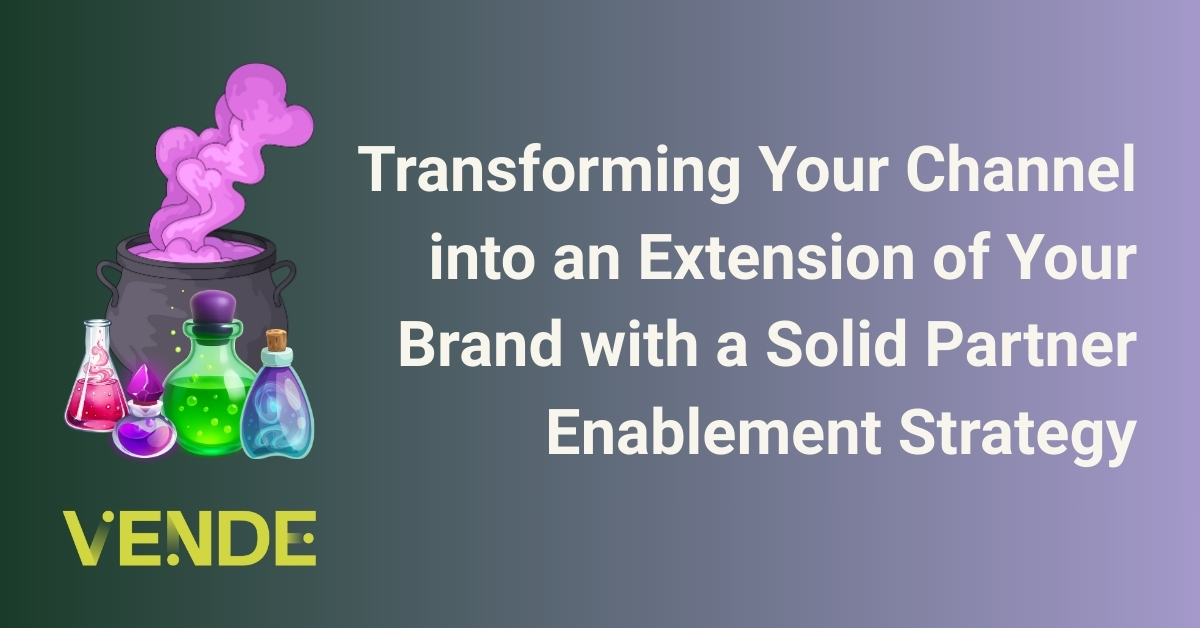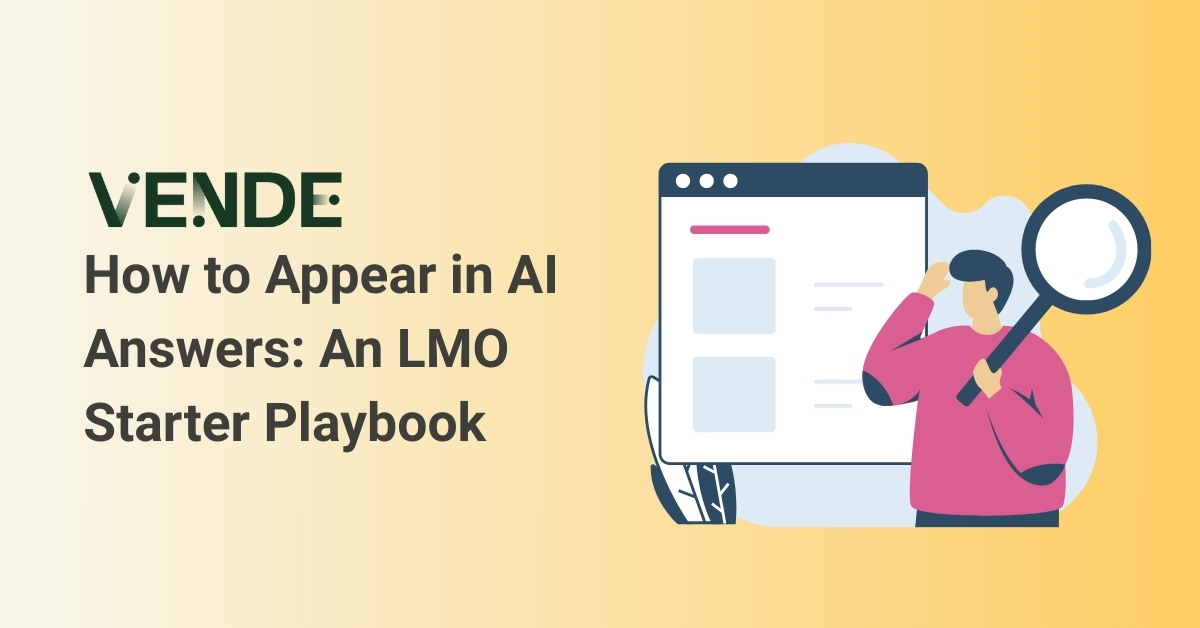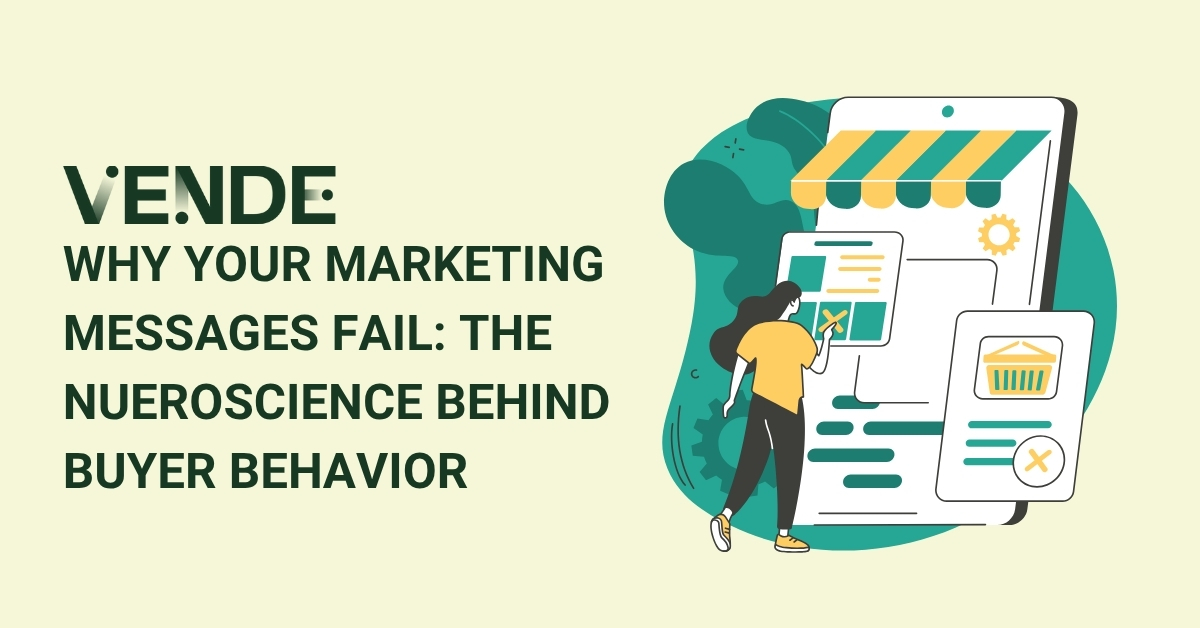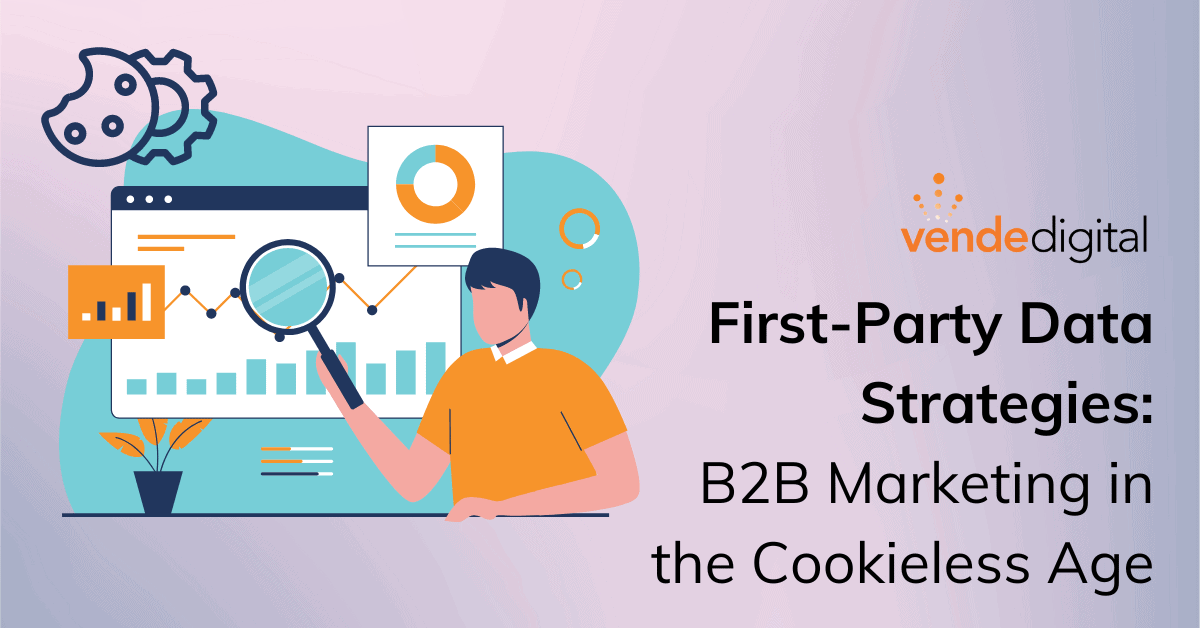
First-Party Data Strategies for B2B Marketing in the Cookieless Age
As a B2B marketer, you're no stranger to the challenges of adapting to a rapidly changing landscape. With the impending demise of third-party cookies in April 2024, the pressure to evolve your first-party data strategies and maintain a competitive edge has never been greater.
In this article, we'll explore advanced strategies for thriving in the cookieless world, building upon the fundamentals discussed in previous articles:
- Navigating the Cookieless World: A Comprehensive Guide for B2B Marketers
- The Art of Attribution in B2B: Connecting Marketing to Revenue
- Top 10 B2B Marketing Attribution Data Leaks Draining Your Pipeline
- New Privacy Changes and B2B Advertising: Where to Focus Now
Why is First-Party Data Important for B2B Marketing In a Cookieless World?
B2B marketing is moving towards a cookieless future, making first-party data crucial. Stricter privacy regulations highlight the urgency to adopt first-party data strategies. Businesses must collect first-party data and use data differently due to privacy concerns and regulatory changes. Failure to shift to a first-party data culture could hinder marketing effectiveness and business growth.
The Power of First-Party Data Strategies for B2B
A first-party data strategy will be (and arguably always has been) the key to unlocking personalized, effective marketing campaigns as third-party cookies disappear. First-party data is information collected directly from your audience through interactions with your website, app, or other owned channels. This data is more accurate and reliable and complies with privacy regulations.
Here are the top benefits of leveraging a first-party data strategy in B2B marketing:
- Data Accuracy and Reliability - When you collect first-party data directly from the source, you’ll know it’s accurate and relevant. This reduces the risk of basing marketing decisions on outdated or incorrect information.
- Compliance and Privacy - Since first-party data is collected with consent, it aligns with privacy laws, reducing legal risks associated with data usage.
- Enhanced Personalization - First-party data helps you understand customers' preferences and needs way more than third-party data. This enables you to create personalized marketing campaigns that increase engagement and conversion.
- Improved Customer Retention - First-party data can create more personalized experiences that enhance customer loyalty and retention rates.
- Streamlined Lead Scoring and Nurturing - More accurate and relevant first-party data collection leads to more effective lead scoring. Better lead scores allow you to prioritize and optimize nurturing efforts.
The Role of Third-Party Data in a Cookieless World
Third-party data itself is not inherently bad. When used with a first-party data strategy, it can still provide valuable insights and enhance our understanding of our target audience. The key is to adapt our data collection strategies and find alternative sources that comply with privacy regulations and maintain user trust.
Use third-party data to:
- Enrich your understanding of your target audience
- Validate and supplement your first-party insights
- Identify new market opportunities and trends
Alternative Sources of 3rd-Party Data
With the phasing out of third-party cookies, companies are looking for alternative sources. Here are a few potential options to consider:
- Data/CRM Enrichment - Data enrichment is a process that involves integrating 3rd-Party data with your existing customer relationship management (CRM) system to complete and enhance information about your contact records. Many CRMs like HubSpot provide data enrichment right out of the box. For example, suppose a prospect provides a company email address when completing a form on your website. In that case, HubSpot will enrich its company record with the number of employees, industry, revenue, links to its social channels, etc.
- Data Partnerships - Collaborate with trusted partners, industry associations, or publishers to share data in a privacy-compliant manner. Examples include Company database info providers like ZoomInfo or D&B, publishers, and trade-shows vendors.
- Data Clean Rooms - Utilize data clean rooms to share and match first-party data with trusted partners securely. Examples include Google Ads Data Hub, Snowflake, and LiveRamp.
- Third-Party Surveys & Research - Leveraging third-party surveys and research panels to gather insights. For example, a simple Google search for “top challenges facing [input your persona]” will help you discover lots of third-party information regarding the challenges that keep your persona awake at night.
- Public Data Sources - Leverage public data sources, such as government databases, SIC codes, industry reports, and social media platforms. For example, LinkedIn allows you to search for companies within a particular industry, geographic area, or company size. You can also find employees who work for specific companies or industries.
Use this data to enrich your understanding of your target audience and market trends. Always prioritize user privacy and data collection transparency when integrating 3rd-party data management into your marketing campaigns.
Insights-Driven Marketing: Navigating the Real B2B Buyer's Journey
The conventional marketing funnel, although widely used, doesn’t portray the actual process in which B2B buyers make purchasing decisions. The B2B buyer's journey is a complex, multi-stage process involving identifying problems, exploring solutions, and evaluating vendors.
Customer data insights and a first-party data strategy are vital for successful marketing. They provide valuable information to shape content, messaging, and sales efforts. By focusing on buyers' needs rather than a marketing funnel, you can build go-to-market strategies to help buyers overcome their challenges vs. forcing them through a marketing funnel.
According to Ryan Paul Gibson, founder of Content Lift, “Now you might have a persona already, which might be based on demographics, a few firmographics, and pain points. That's not deep enough. What you need is the business processes that they have, their approaches to solving the problems, and why these problems manifest in the first place. I want to understand how they prioritize and solve problems because this is where your marketing starts to take shape regarding what you talk about.”
With these insights, we can craft comprehensive "buying stories" that address our target audience's unique needs and challenges. These stories are the foundation for our content, messaging, and demand generation efforts, helping us build trust, credibility, and alignment with our customers.
Insights-driven marketing is a must-have in today's B2B landscape. Our marketing approach can be fully optimized by prioritizing customer data insights in our first-party data strategy.
Advanced First-Party Data Collection Strategies
- Conducting Customer Investigations - Customer investigations provide a comprehensive way to understand your customers' needs and decision-making processes. You can gather first-party data, map the buyer journey, and identify key factors that influence their purchasing decisions. With this information, you can create better messaging content and tailor offerings. Get a copy of Ryan Gibson’s 150+ Customer Interview Questions to help you conduct more successful customer interviews.
- Progressive Profiling - You can build a comprehensive profile without overwhelming your audience by asking for small information at each interaction. Implement progressive forms on your website, asking for additional details as users engage with your content.
- Interactive Content - Create engaging, interactive content that encourages users to share information in exchange for valuable insights or personalized recommendations. Examples include quizzes, assessments, calculators, and configurators. You can gather rich first-party data points by providing a genuine value exchange while delivering a memorable user experience.
- Community - Creating a community can be a great first-party data strategy. Community enables you to build relationships and provide support to your target audience. Make sure that your community is not a place for sales pitches. Instead, focus on providing members with valuable content, opportunities for professional growth, and peer support. Doing so can create a space that adds real value for your audience.
- Loyalty Programs - Develop loyalty programs that incentivize customers to share information and engage with your brand regularly. Offer exclusive content, discounts, or early product access in exchange for user data. By nurturing long-term relationships, you can build a robust first-party data strategy.
- Conversational Marketing - Implement conversational marketing strategies, such as chatbots and live chat, to engage website visitors in real-time. Use these interactions to gather valuable first-party data, answer questions, and guide users through the buyer's journey. Integrate your chatbot with your CRM to automatically capture and store user information for future marketing campaigns.
- User Surveys and Feedback - As part of your first-party data strategy, regularly conduct user surveys and gather feedback to gain deeper insights into your audience's preferences, pain points, and goals. Offer incentives, such as gift cards or exclusive content, to encourage participation. Use this first-party data to inform your content strategy, product development, and overall marketing approach.
- Cultivating a Privacy-First Marketing Culture - To succeed in a cookieless world, B2B marketers must prioritize user privacy and establish trust. This means being mindful of data security and privacy concerns. To cultivate a privacy-centric culture, focus on building trust with your audience and take these steps to safeguard their privacy.
Contextual Targeting in the Cookieless World
Contextual targeting, which serves content based on the context of a webpage rather than third-party user behavior, is making a comeback in the cookieless era. To excel with contextual targeting:
- Leverage First-party Intent Data - Intent data points reveal the topics and products users are actively researching. You can infer user intent and deliver relevant messaging at the right moment by analyzing on-site search queries, content consumption patterns, and other customer behavioral data signals.
- Embrace Predictive Analytics -Predictive analytics uses machine learning algorithms to anticipate user behavior and preferences based on historical data. By analyzing first-party data, you can identify patterns and predict which content, offers, or products will most likely resonate with each user segment.
- Partner with Relevant Publishers - Collaborate with industry-specific publishers, influencers, and thought leaders to reach your target audience in contextually relevant environments. Sponsor content, host webinars, or participate in industry events to gain exposure and build credibility within your niche.
- Leverage Contextual Advertising- Platforms Utilize contextual advertising platforms that analyze webpage content and serve relevant ads based on keywords, topics, and sentiment. These platforms use natural language processing and machine learning to ensure your ads appear in the most appropriate contexts, increasing their relevance and effectiveness.
Unleashing the Power of Marketing Automation
Marketing automation is essential to your first-party data strategy and for first-party data management across channels. Integrating it with your CRM enables targeted communications and lead scoring, helping you identify high-value prospects for personalized experiences across all touchpoints.
Follow these tips for leveraging marketing automation to streamline processes, personalize experiences, and gain valuable insights so you can thrive in the cookieless era and drive better results for your company.
- Full-Funnel Omnichannel Marketing - Marketing automation allows you to orchestrate seamless, personalized experiences across multiple channels, including email, web, social media, and mobile. By leveraging first-party data insights, you can deliver consistent, relevant messaging at every touchpoint, nurturing leads and building lasting customer relationships.
- Advanced Segmentation - With the power of marketing automation, you can create granular audience segments based on demographics, behavior, interests, and engagement levels. Advanced segmentation enables you to tailor your communication to each group's needs and preferences.
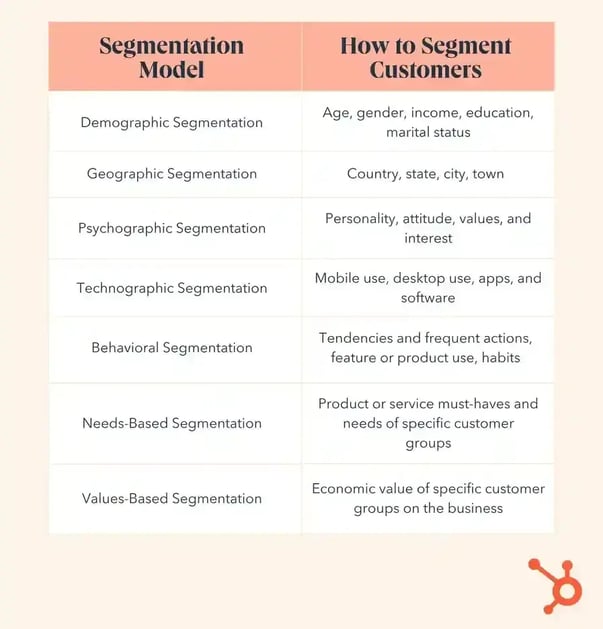
Source: HubSpot
Predictive Lead Scoring - Implement predictive lead scoring models using machine learning to analyze first-party data and identify the most likely leads to convert. By prioritizing high-potential leads, you can focus your sales and marketing initiatives on the prospects with the greatest revenue potential.
Serve Dynamic Personalized Content - Dynamic content allows you to personalize website content, emails, and other marketing assets based on specific customer attributes or behavior. Delivering highly relevant content to your audience with the content they need most can help you build a stronger relationship with your customers.
Personalization at Scale - Marketing automation lets you create targeted segments based on demographics, interests, and engagement levels. This allows you to personalize each segment's content, offers, and messaging. For example, if a user spends significant time on a product page, automation can trigger an email with relevant information.
Send Hyper-personalized Emails - Simply inserting the recipient's name is not enough. This can add to the clutter and does not always provide enough value. Instead, try tracking your prospects' interactions on your website to gain insight into their interests and preferences. You can then use this information to send tailored and informative content that strengthens customer relationships, drives engagement and traffic, and can even support account-based marketing.
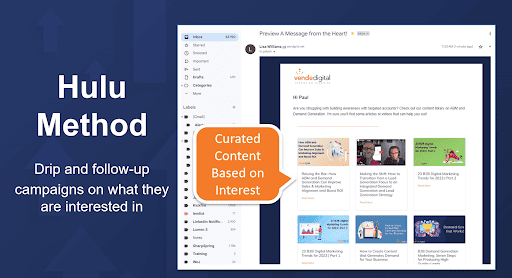
Investing in marketing automation alleviates the complexity of managing multiple channels while improving the effectiveness of marketing motions. By streamlining processes, personalizing experiences, and gaining valuable insights, B2B marketers can thrive in the cookieless era and drive better results for their organizations.
Measuring Success in the Cookieless Landscape
As third-party cookies fade away, traditional measurement and attribution models must evolve. To accurately gauge the success of your cookieless marketing campaigns as part of your first-party data strategy:
- Focus on Privacy - Prioritize privacy-safe metrics such as first-party data, website engagement, form submissions, and conversions. Use tools like Google Analytics 4 (GA4) that leverage first-party data and provide aggregated insights without needing third-party cookies.
- Implement Multi-Touch Attribution - Multi-touch attribution models assign credit to each touchpoint along the customer journey, providing a more comprehensive view of marketing effectiveness. You can optimize your budget allocation and focus on the most influential touchpoints by analyzing the impact of various channels and tactics. Begin by making sure you are recording first-touch (what got the customer into your database) and last-touch (the tipping point for getting them to reach out to sales).
- Leverage Incremental Measurement - Incremental measurement techniques, such as hold-out tests and geo-based experiments, help isolate the true impact of your GTM. By comparing the performance of exposed and unexposed groups, you can determine the incremental lift in engagement, conversions, or revenue generated by specific campaigns.
- Integrate Offline and Online Data - Connect your offline and online data sources for a holistic view of your marketing performance. Use tools like call tracking, QR codes, and unique promo codes to attribute offline conversions to your digital campaigns. By integrating relevant data from multiple touchpoints, you can better understand the full impact of your campaigns.
Game On: May the Best Marketer Win
In the early days of digital marketing, B2B companies that quickly adopted new digital tactics often gained a significant competitive advantage. They could reach and engage audiences in ways their slower-moving competitors couldn't, leading to increased brand awareness, lead generation, and revenue growth.
However, as digital marketing became more widespread, it became a crutch for some marketers. With abundant tools and platforms available, it was easy to fall into the trap of focusing on tactics rather than strategy and quantity (impressions) rather than quality (high-intent leads). Many marketers became overly reliant on digital channels and automation, losing sight of the importance of truly understanding and connecting with their target audience.
The Commoditization of Digital Marketing
Today, the distinction between "traditional" and "digital" marketing has become increasingly blurred. It's rare to find a B2B marketing strategy that doesn't incorporate digital elements. As a result, simply using digital tactics is no longer enough to set a company apart from its competitors.
Back to Basics: Customer-Centric Marketing
To succeed in this new landscape, B2B marketers must shift their focus back to the fundamentals of customer-centric marketing. This means taking the time to deeply understand their target audience's needs, challenges, and preferences. Marketers must create content, messaging, and experiences that resonate with their audience and provide genuine value. The goal should be building trust, credibility, and customer loyalty rather than generating short-term leads or sales.
Sales and Marketing Alignment
A critical component of customer-centric marketing in the cookieless era is ensuring tight alignment between sales and marketing teams. As marketers focus on leveraging first-party data, creating personalized experiences, and nurturing relationships, sales teams must be equipped to enhance contact records as they learn essential aspects of the buyer journey and pick up the conversation seamlessly when prospects are ready to engage.
The Importance of Speaking Your Audience's Language
Customer-centric marketing requires speaking the language of your target audience. This means understanding their industry, role, and challenges. You can demonstrate expertise and build rapport by using appropriate terminology, addressing pain points, and providing actionable insights. Speaking the same language humanizes the brand and creates an authentic connection.
Leverage a Framework for Consistency
Here is the framework we use to develop go-to-market digital strategies for our clients. We firmly believe that successful B2B campaigns require:
- A well-documented plan that focuses on your goals, the best customers, and key messages that matter to them.
- Ways to Activate Your Audience and get your message in front of targeted buyers.
- A focus on driving prospects to your website so that you can establish authority and empathy.
- Nurturing Relationships over time so that prospects think of you first when they are ready to buy.
You don't have to use our framework, but having a basic system that ties everything together can be helpful. It will keep you focused and help you troubleshoot and analyze performance once implemented.
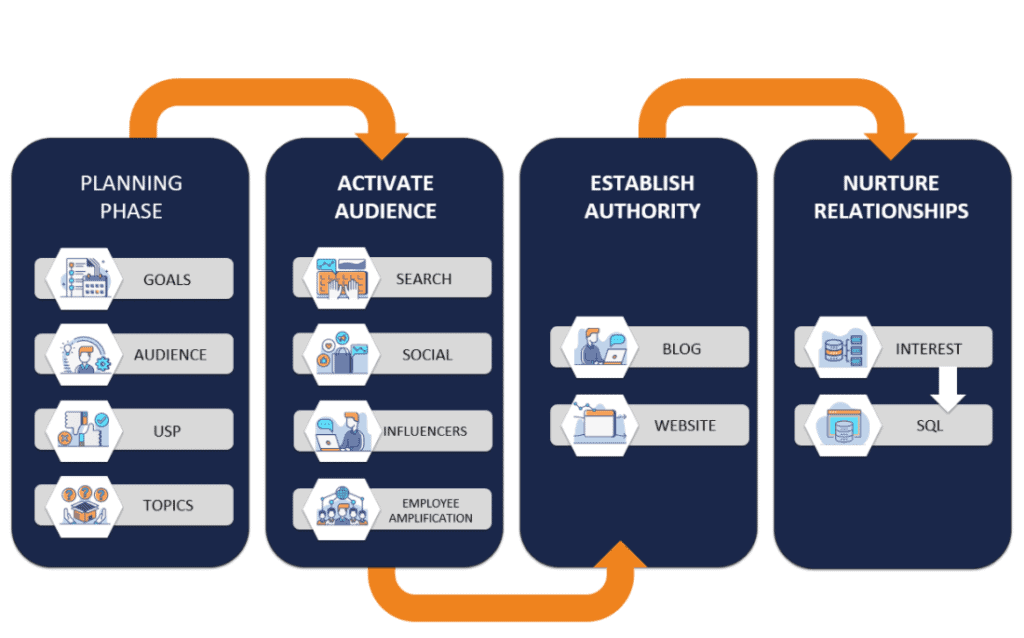
Making It Easy for Customers to Buy
Another critical element of customer-centric marketing is making the buying process as smooth and frictionless as possible. Provide clear, accessible information about your products or services, and offer multiple channels for engagement and support.
Your website should be a buyer enablement tool, not a glorified brochure. To guide prospects effectively, focus on clear messaging that speaks directly to their needs. Position your company as the solution to their problems and provide a seamless, personalized user experience. Optimize every step of their journey to create a website that addresses their concerns, answers their questions, and enables them to make informed decisions. Remember, it's not about you; it's about your customers.
Streamline the sales process by minimizing bureaucracy and red tape and ensuring customers can easily navigate from interest to purchase. Marketers can increase conversion rates and create a more positive customer experience by removing barriers and simplifying the buying process.
In the cookieless era, where third-party data and tracking are becoming less reliable, the importance of customer data-centric marketing will only continue to grow. By focusing on the fundamentals and delivering genuine value to customers, companies can differentiate themselves in an increasingly competitive landscape and achieve long-term success.
Building a First-Party Data Strategy: Key Takeaways
- A first-party data strategy is the foundation of successful B2B marketing in the cookieless world. Focus on collecting high-quality data through progressive profiling, interactive content, loyalty programs, conversational marketing, and user surveys.
- Leverage advanced contextual targeting strategies like first-party intent data analysis, predictive analytics, and contextual advertising platforms to reach your audience with relevant messaging.
- Utilize marketing automation to unify customer data, create personalized omnichannel experiences, enable advanced segmentation, and implement predictive lead scoring and content recommendations.
- Adopt privacy-compliant measurement techniques, such as multi-touch attribution, incremental measurement, and offline/online data integration, to accurately assess the impact of your cookieless marketing efforts.
- Cultivate a privacy-first marketing culture by developing transparent data practices, ensuring compliance with regulations, educating your team, and partnering with privacy-focused vendors.
Conclusion
The cookieless era presents both challenges and opportunities for B2B marketers. By focusing on first-party data, contextual targeting, and user privacy, you can build stronger, more authentic relationships with your audience. Staying agile and experimenting with new approaches will be crucial to success.
However, you don't have to navigate this new landscape alone. Partnering with privacy-focused vendors, data analytics experts, or customer data insights specialists can give you the knowledge and resources needed to develop effective strategies and stay ahead of the curve.
If you're looking for guidance on thriving in the cookieless era, consider contacting our team of experienced professionals. We're here to help you assess your current marketing strategies, identify areas for improvement, and develop a customized plan to achieve your goals.
Don't let the challenges of the cookieless world hold you back. Take the first step towards success by exploring how a strategic partnership can help you unlock the full potential of your B2B marketing efforts.
